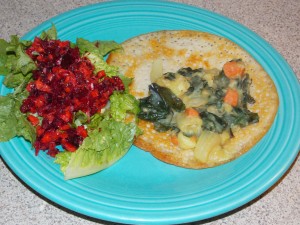Indian Dosas – Fun to Make, a Treat to Eat!
Fresh from the Hungry Mom Kitchen…
Indian Dosas!
A mountain of fresh veggies seemed to be growing out of Nandini’s kitchen counter: beets, spinach, squash, mushrooms, broccoli, and potatoes – a one day supply for two adults and three teenage girls, she said.
What on earth was she going to make with all that food?
The answer was not long in coming.
Breezing around the kitchen in a sari, Nandini reminded me of Lakshmi, the four-armed Indian goddess, simultaneously stirring steaming veggies with one hand and flipping dosas with the other.
It smelled fantastic.
My daughters and I were finally led to her formal dining room, where a table set with tempting sauces and chutneys awaited us.


Dosas have no flour, so they are gluten-free. Instead, they’re made with rice and “dal”- split lentils that have been stripped of their outer shell.
Would she teach how me to make them?
A native of Bangalore, India, Nandini’s syllables popped. “Definitely!” she said.
Over the years I’ve made Nandini’s dosas many times, and have to say, she was “spot on.” People have asked why I don’t just buy the packaged mix. It would be a lot easier.
I don’t because that’s not what Nandini did. Besides, I like making food from scratch.
Unlike some “scratch” dishes, however, dosas are not time-consuming. But you’ll have to start a day ahead to allow the fermentation process to take place. Here’s the way Nandini makes them.
INGREDIENTS
1 C Basmati Rice (Can use regular white rice, or half-brown rice, half white. Nandini did not use parboiled rice – which is shown in the video. And I never use it.)
1/4 C Urad Dal (get this at an Indian grocery store, or international market.)
1 tsp. Fenugreek Seeds (or Menthi)
(For extra crispy dosas, Nandini says you can substitute a little Chana Dal for some of the Urad Dal. Chana Dal is made from chickpeas – but I have never added this.)
DAY 1
Rinse and drain the Dal and Rice separately in a strainer. Put both in a large glass or stainless steel bowl.
Cover with clear water.
Cover with lid or plastic wrap and let sit overnight on the counter. Do not refrigerate.
DAY 2
The next day, add about ½ Tsp. Sea Salt.
Pour everything into in the blender (Note on consistency: If there is quite a bit of water remaining in your bowl, don’t add it all at once. You want to be sure your batter isn’t too thin. It should be like medium-thick pancake batter. Not runny. If it’s too thick, it will not blend, so add a little water until the mixture churning nicely.)
When blending is complete, the batter should be smooth.
Cover and set aside for 6 to 12 hours. The mixture is now going to ferment. (Yes, this is actually good for you!) I usually let it sit overnight. Do not refrigerate.
Now your dosa batter is ready!
You’ll need a Heavy Skillet and Cooking Oil. I’m going to tell you how I do it in my cast iron skillet, because I get great results. Also, I use grape seed or olive oil, but you can use just about any kind.
Heat the skillet over medium-high heat. If you have a non-stick skillet, you will not need to coat the surface with oil. But I spread a little oil on the bottom of my cast iron skillet with a paper towel. You aren’t frying the dosas, only browning them.
When the pan is hot, (a drop of water will hiss), use a Small Soup Ladle to pour a good-size dollop into the center of the pan.
Immediately begin making circular motions with the back of the ladle to spread the batter towards the outer edge of the pan. You want to make one large circle. (Check YouTube for a demonstration.)
Pour a small amount of oil around the edges to keep dosas from sticking. Or brush the top of your dosa with oil. Tip the pan to spread oil, if necessary
After one minute, check the edges with a spatula and see if the dosa is ready. I flip my dosas, to get them brown on both sides.
If your first dosa out of the pan is a flop, scrape it out and start again. They will get better. I toss a dash of salt into the pan before adding batter to keep it from sticking. And be sure the pan is hot enough.
As I mentioned earlier, if you add too much oil before pouring in your batter, it will not spread nicely. Grrrr. If that happens, do not despair! Just cook it the best you can, or scrape it out. Let the pan get hot again, and start over. This time, try not adding oil to the pan before pouring in the batter. It takes practice!
Drain dosas between paper towels.
Make as many as you need for the meal. I usually figure two per person because we really like them.
Store remaining batter in the refrigerator in a covered container. I have used it several days later with fine results.
Serving Suggestions (for people like me who are not familiar with Indian cooking!)
Fill dosas with any of the following combinations: Curried veggies, boiled potatoes, avocado, tomato, steamed spinach or chard, grated cheese, cottage cheese, or sour cream. Serve with soup or chili instead of crackers or tortillas. Enjoy! FFG




Leave a Reply